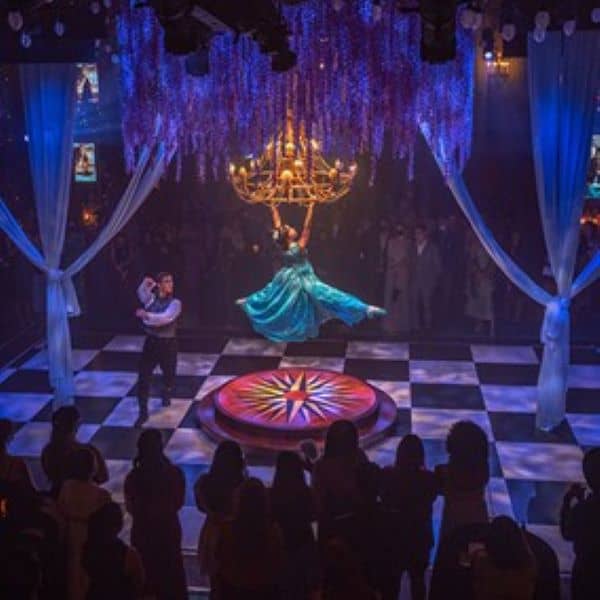[ad_1]
Featured image by Zyabich
As safety restrictions ease and with consumers eager to engage, in-person activities and meetups are becoming popular again. In fact, 81% of marketers plan to host live experiences this year, according to a study done by Agency EA. So what does this mean for brands looking to reconnect with their customers? It means that experiential marketing events are set to make a big comeback.
Experiential Marketing 101
Experiential marketing strategies fully immerse consumers within a brand or product. In other words, this form of marketing prompts customers to experience the brand instead of merely pushing them to buy. For this reason, experiential marketing also called engagement marketing. Most of the time, it includes a captivating display or an engaging event.
However, experiential marketing differs from traditional event marketing, as it allows two-way interaction between the brand and its customers. And while event marketing gives all participants the same experience at once, experiential marketing offers unique, memorable experiences.
Some Examples of Experiential Strategies
Want to see it in action? Here are some recent examples of experiential marketing:
A Product-Centered Example with Netflix’s The Queen’s Ball: A Bridgerton Experience

Image Source: Netflix Bridgerton Experience

Netflix transported viewers into the world of their hit TV show, Bridgerton, in The Queen’s Ball: A Bridgerton Experience. The experience includes costumed characters, scavenger hunts, period dance lessons, elaborate decorations, and more. Merchandise such as opera gloves and makeup products used in the production are also available for purchase.
With this event, Netflix brings this series to life and places viewers directly in the story. In the end, the event fosters a stronger following for the show. It boosts audience engagement and ultimately extends the life of the series.
A Brand-Focused Experience with OGX’s Love Labs

Image Source: OGX on Event Marketer
OGX’s Love Labs offered guests a memorable shower photo op, snacks highlighting the brand’s ingredients, and a hands-on science demo.
These experiences showcased the science and ingredients behind their brand. Basically, the company showed off their leadership in hair care. At the same time, they promoted one of the brand’s major values, self-love, by presenting participants with moments to celebrate their hair.
At first glance, this might seem like a product-led strategy. However, OGX focused on displaying their ongoing commitment to quality ingredients and the celebration of self-love. They held up the brand’s identity rather than focusing on one product or collection.
A Little Mix of Both with Häagen-Daz’s Bodega Speakeasy

Image Source: Häagen-Dazs Twitter
Häagen-Dazs transformed an empty shop into a colorful, classic New York City bodega to pay tribute to the brand’s roots and highlight their new “City Sweets” collection. Hidden within the entire space were Easter eggs and varied nods to Häagen-Dazs’s original creators. This was evident even in the bodega’s name, Rose and Reuben’s.
Every aisle was dedicated to one of the brand’s new flavors. For example, one aisle featured Häagen-Dazs’s new churro-inspired Dulce de Leche ice cream. To top it off, behind a freezer door was a speakeasy where the air was filled with live music and visitors could sample new flavors.
RELATED ARTICLE: WHY LOCAL SEO IS IMPORTANT FOR YOUR BUSINESS
Why Experiential Marketing Is Critical
Experiential marketing helps businesses establish a deeper, more lasting relationship between the brand and its customers. Since this strategy delivers one-on-one engagement, consumers feel connected rather than pressured to buy. This helps create a lasting impact, encouraging brand loyalty. In short, it increases customer lifetime value (CLV).
Here’s a quick snapshot of all the benefits that experiential marketing has to offer. It will help you:
- Humanize your brand
- Differentiate your business from your competitors
- Build brand and product awareness
- Develop deeper customer relationships
- Increase sales
- Generate valuable leads
- Collect vital customer data in real time
The Ebb and Flow of Experiential Marketing
Before March 2020, experiential marketing was seeing significant growth in popularity. In fact, over a third of CMOs expected to spend up to 50% of their budget on experiential marketing campaigns, according to a survey conducted by Freeman in 2017.
Additionally, based on Bizzabo’s 2018 event marketing study, 80% of businesses believed live events and experiences were going to be an important component of their success.
Then, quarantine happened.
This had a devastating effect on experiential marketing. The pandemic prevented in-person marketing experiences. As a result, many businesses were forced to cancel their events altogether. Others pivoted toward virtual or socially distant experiences such as drive-in or drive-by events. Basically, businesses were trying to ensure people’s safety.
But now, the world is gradually finding its way toward a new normal, and safety restrictions are beginning to fade. However, some strategies marketers were forced to accept during the lockdown may well continue indefinitely.
RELATED ARTICLE: 4 WAYS ENTERPRISES CAN PREPARE FOR THE NEXT NORMAL
What Experiential Marketing Could Look Like over the Next Couple of Years
Nonetheless, safety measures are slowly lifting. Moreover, people are eager to attend in-person events. Therefore, experiential marketing is set to make a big comeback, even though the past couple of years have no doubt changed the way businesses approach experiential campaigns.
So what do you need to keep in mind when you’re planning experiential events?
Virtual Technology in Experiential Marketing
Even though many online-only events will dwindle with Zoom fatigue setting in, virtual technology will still play an important role in experiential marketing.
RELATED ARTICLE: 4 KEY ASPECTS OF A SUCCESSFUL VIRTUAL EVENT
Integrating technologies such as augmented reality (AR), virtual reality (VR), and video into an experiential campaign will allow your brand to reach a wider audience.
So, for example, if your pop-up experience is in LA, one or more of these technologies will enable prospects in different cities and countries to join the experience. This could even increase your international sales.
Smaller Attendee Groups and Outdoor Community Events
Safety is still a priority for businesses and consumers alike. Therefore, smaller, more intimate attendee groups are likely to be popular.
This is not such a bad thing, however. Companies can benefit from a smaller group setting, as they can address guests directly. In this way, they will be able to build deeper relationships.
In short, consumers will connect with your brand on a personal level when they attend one of your small in-person events. This can lead to longer-lasting brand loyalty.
Greater Consumer Interest in Advocacy and Transparency
More and more consumers, especially Millennials and Gen Zers, are looking for brands that genuinely advocate for the causes the company claims to care about. In other words, they want their purchases to reflect a commitment to generate social good.
Moreover, they want to know how the company supports these causes. Transparency is a primary concern.
With sincere advocacies and meaningful brand values, you develop a positive business reputation as consumers learn to associate your brand with important causes.
More Hands-on Experiences
After many contactless and touch-free activities, we’re ready to get our hands out there!
This means interactive experiences that invoke the sense of touch. Think demos, games, samples, and so on. These types of events will grow in popularity, as they tend to leave lasting impressions on consumers.
Setting Your Business up for Success
Consumers’ growing desire to get out of the house and experience life makes experiential marketing an obvious choice for businesses in the next few years. Just by organizing a personalized, memorable experience for your customers, you show them how much you value them.
To ensure your business’s success with experiential marketing, here’s a snapshot of best practices for engagement marketing:
- Use experiences to highlight your brand’s values
- Appeal to your audience’s senses and emotions
- Create something visually striking
- Organize hybrid events by combining virtual and real-life experiences
- Collect vital customer insights during or after the event
- Incorporate hands-on and interactive elements
- Research your environment before creating any physical exhibits
- Stay relevant and true to your brand’s identity
With these practices in mind, you can start crafting successful, engaging experiences that maximize your customers’ lifetime value to your business.
About the Author

Kim Sayers has been a content creator for more than four years. She writes for small businesses, specifically focusing on marketing, sales, and communication.
She currently works with telecom experts to gain insights into how businesses can use communication tools to effectively run their businesses. Find Kim online at LinkedIn.
RELATED ARTICLE: MILLENNIAL BUSINESS OWNERS CASH IN ON A CHANGING WORLD
[ad_2]
Source link
Leave a Reply